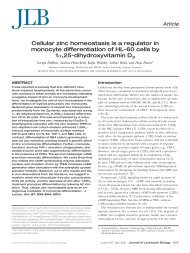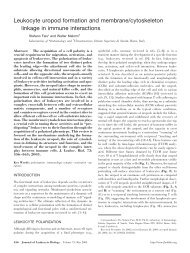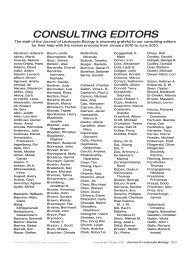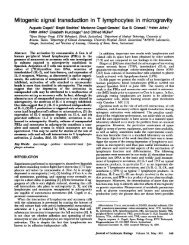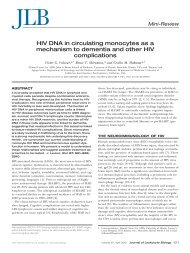Depletion of eosinophils in mice through the use - Journal of ...
Depletion of eosinophils in mice through the use - Journal of ...
Depletion of eosinophils in mice through the use - Journal of ...
You also want an ePaper? Increase the reach of your titles
YUMPU automatically turns print PDFs into web optimized ePapers that Google loves.
phils. However, <strong>the</strong> surface expression <strong>of</strong> CCR3 on mo<strong>use</strong> Th2<br />
cells, if present, was too low for detection by flow cytometry. In<br />
addition, our study shows that mo<strong>use</strong> Th2 cells are not<br />
responsive to eotax<strong>in</strong> ei<strong>the</strong>r by calcium mobilization assay or<br />
chemotaxis. This contrasts with a recent report <strong>of</strong> preferential<br />
sta<strong>in</strong><strong>in</strong>g with an anti-huCCR3 mAb as well as <strong>the</strong> eotax<strong>in</strong>mediated<br />
chemotaxis and calcium flux <strong>of</strong> human Th2 cells [8].<br />
Our observation <strong>of</strong> low levels <strong>of</strong> mCCR3 mRNA <strong>in</strong> activated<br />
Th2 cells, however, is consistent with a more recent report on<br />
CCR3 mRNA expression observed <strong>in</strong> human Th1 and Th2 cells<br />
[27]. It is quite possible that CCR3 expression on Th2<br />
population is tightly l<strong>in</strong>ked to an as yet unknown activation<br />
state and this could expla<strong>in</strong> <strong>the</strong> differences observed between<br />
different reports. We have also demonstrated that anti-mCCR3<br />
mAbs <strong>of</strong> <strong>the</strong> rat IgG2b isotype can also be <strong>use</strong>d to achieve<br />
partial to complete depletion <strong>of</strong> <strong>eos<strong>in</strong>ophils</strong> <strong>in</strong> vivo. Treated<br />
animals were <strong>use</strong>d <strong>in</strong> restimulation assays <strong>of</strong> lung cells, which<br />
showed no <strong>in</strong>crease <strong>in</strong> Th2-<strong>in</strong>duced cytok<strong>in</strong>e levels. In short,<br />
<strong>the</strong>se assays taken toge<strong>the</strong>r show that CCR3 is not a significant<br />
chemok<strong>in</strong>e receptor for mo<strong>use</strong> Th2 cells. Recent studies have<br />
shown that o<strong>the</strong>r chemok<strong>in</strong>e receptors such as CCR8 may have<br />
a far more significant role on Th2-specific cellular migration<br />
[28]. These antibodies should be <strong>use</strong>ful <strong>in</strong> future studies aimed<br />
at determ<strong>in</strong><strong>in</strong>g <strong>the</strong> roles <strong>of</strong> <strong>eos<strong>in</strong>ophils</strong> <strong>in</strong> <strong>in</strong>fectious and<br />
<strong>in</strong>flammatory diseases.<br />
ACKNOWLEDGMENTS<br />
DNAX Research Institute is supported by Scher<strong>in</strong>g-Plough<br />
Corporation. The authors would like to thank Debra Liggett for<br />
syn<strong>the</strong>sis <strong>of</strong> DNA, Dan Gorman, Allison Helms, and Connie<br />
Huff<strong>in</strong>e for DNA sequenc<strong>in</strong>g analysis, Dr. Terri McClanahan<br />
and Kar<strong>in</strong> Bacon for provid<strong>in</strong>g cDNA libraries, Dr. Donna<br />
Rennick for histology consultation, Dr. Joe Hedrick for chemotaxis<br />
analysis, Dr. Kenneth Soo for his helpful suggestions, and<br />
Gary Burget and Dr. Maribel Andonian for graphics work.<br />
REFERENCES<br />
1. Hedrick, J., Zlotnik, A. (1996) Chemok<strong>in</strong>es and lymphocytes. Curr. Op<strong>in</strong>.<br />
Immunol. 8, 343–347.<br />
2. Roll<strong>in</strong>s, B. (1997) Chemok<strong>in</strong>es. Blood 90, 909–928.<br />
3. Kelner, G. S., Kennedy, J., Bacon, K. B., Kleyensteuber, S., Largaespada,<br />
D. A., Jenk<strong>in</strong>s, N. A., Copeland, N. G., Bazan, J. F., Moore, K. W., Schall,<br />
T. J., Zlotnik, A. (1994) Lymphotact<strong>in</strong>: a cytok<strong>in</strong>e that represents a new<br />
class <strong>of</strong> chemok<strong>in</strong>e. Science 266, 1395–1399.<br />
4. Bazan, J. F., Bacon, K. B., Hardiman, G., Wang, W., Soo, K., Rossi, D.,<br />
Greaves, D. R., Zlotnik, A., Schall, T. J. (1997) A new class <strong>of</strong><br />
membrane-bound chemok<strong>in</strong>e with a CX3C motif. Nature 385, 640–644.<br />
5. Pan, Y., Lloyd, C., Zhou, H., Dolich, S., Deeds, J., Gonzalo, J. A., Vath, J.,<br />
Gossel<strong>in</strong>, M., Ma, J., Dussault, B., Woolf, E., Alper<strong>in</strong>, G., Culpepper, J.,<br />
Gutierrez-Ramos, J. C., Gear<strong>in</strong>g, D. (1997) Neurotact<strong>in</strong>, a membraneanchored<br />
chemok<strong>in</strong>e upregulated <strong>in</strong> bra<strong>in</strong> <strong>in</strong>flammation. Nature 387,<br />
611–617.<br />
6. Ponath, P. D., Q<strong>in</strong>, S., Post, T. W., Wang, J., Wu, L., Gerard, N. P., Newman,<br />
W., Gerard, C., Mackay, C. R. (1996) Molecular clon<strong>in</strong>g and characterization<br />
<strong>of</strong> a human eotax<strong>in</strong> receptor expressed selectively on <strong>eos<strong>in</strong>ophils</strong>. J.<br />
Exp. Med. 183, 2437–2448.<br />
7. Jose, P. J., Adcock, I. M., Griffiths-Johnson, D. A., Berkman, N., Wells,<br />
T. N., Williams, T. J., Power, C. A. (1994) Eotax<strong>in</strong>: clon<strong>in</strong>g <strong>of</strong> an eos<strong>in</strong>ophil<br />
chemoattractant cytok<strong>in</strong>e and <strong>in</strong>creased mRNA expression <strong>in</strong> allergenchallenged<br />
gu<strong>in</strong>ea-pig lungs. Biochem. Biophys. Res. Commun. 205,<br />
788–794.<br />
8. Sallusto, F., Mackay, C., Lanzavecchia, A. (1997) Selective expression <strong>of</strong><br />
<strong>the</strong> eotax<strong>in</strong> receptor CCR3 by human T helper 2 cells. Science 277,<br />
5005–5007.<br />
9. Lukacs, N. W., Strieter, R. M., Kunkel, S. L. (1995) Leukocyte <strong>in</strong>filtration<br />
<strong>in</strong> allergic airway <strong>in</strong>flammation. Am. J. Respir. Cell. Mol. Biol. 13, 1–6.<br />
10. Kay, A. B., Corrigan, C. J. (1992) Asthma. Eos<strong>in</strong>ophils and neutrophils. Br.<br />
Med. Bull. 48, 51–64.<br />
11. Ro<strong>the</strong>nberg, M. E., MacLean, J. A., Pearlman, E., Luster, A. D., Leder, P.<br />
(1997) Targeted disruption <strong>of</strong> <strong>the</strong> chemok<strong>in</strong>e eotax<strong>in</strong> partially reduces<br />
antigen-<strong>in</strong>duced tissue eos<strong>in</strong>ophilia. J. Exp. Med. 185, 785–790.<br />
12. Ganzalo, J. A., Jia, G. Q., Aguirre, V., Friend, D., Coyle, A. J., Jenk<strong>in</strong>s,<br />
N. A., L<strong>in</strong>, G. S., Katz, H., Lichtman, A., Copeland, N., Kopf, M.,<br />
Gutierrez-Ramos, J. C. (1996) Mo<strong>use</strong> eotax<strong>in</strong> expression parallels eos<strong>in</strong>ophil<br />
accumulation dur<strong>in</strong>g lung allergic <strong>in</strong>flammation but it is not restricted<br />
to a Th2-type response. Immunity 4, 1–14.<br />
13. Daugherty, B. L., Siciliano, S. J., DeMart<strong>in</strong>o, J. A., Malkowitz, L., Sirot<strong>in</strong>a,<br />
A., Spr<strong>in</strong>ger, M. S. (1996) Clon<strong>in</strong>g, expression, and characterization <strong>of</strong> <strong>the</strong><br />
human eos<strong>in</strong>ophil eotax<strong>in</strong> receptor. J. Exp. Med. 183, 2349–2354.<br />
14. Forssmann, U., Uguccioni, M., Loetscher, P., Dah<strong>in</strong>den, C. A., Langen, H.,<br />
Thelen, M., Baggiol<strong>in</strong>i, M. (1997) Eotax<strong>in</strong>-2, a novel CC chemok<strong>in</strong>e that is<br />
selective for <strong>the</strong> chemok<strong>in</strong>e receptor CCR3, and acts like eotax<strong>in</strong> on human<br />
eos<strong>in</strong>ophil and basophil leukocytes. J. Exp. Med. 185, 2171–2176.<br />
15. Post, T. W., Bozic, C. R., Ro<strong>the</strong>nberg, M. E., Luster, A. D., Gerard, N.,<br />
Gerard, C. (1995) Molecular characterization <strong>of</strong> two mur<strong>in</strong>e eos<strong>in</strong>ophil beta<br />
chemok<strong>in</strong>e receptors. J. Immunol. 155, 5299–5305.<br />
16. Hedrick, J. A., Saylor, V., Figueroa, D., Mizoue, L., Xu, Y., Menon, S.,<br />
Abrams, J., Handel, T., Zlotnik, A. (1997) Lymphotact<strong>in</strong> is produced by NK<br />
cells and attracts both NK cells and T cells <strong>in</strong> vivo. J. Immunol. 158,<br />
1533–1540.<br />
17. Tony, H. P., Parker, D. C. (1985) Major histocompatibility complexrestricted,<br />
polyclonal B cell responses result<strong>in</strong>g from helper T cell<br />
recognition <strong>of</strong> antiimmunoglobul<strong>in</strong> presented by small B lymphocytes. J.<br />
Exp. Med. 161, 223–241.<br />
18. Kurt-Jones, E. A., Hamberg, S., Ohara, J., Paul, W. E., Abbas, A. K. (1987)<br />
Heterogeneity <strong>of</strong> helper/<strong>in</strong>ducer T lymphocytes. I. Lymphok<strong>in</strong>e production<br />
and lymphok<strong>in</strong>e responsiveness. J. Exp. Med. 166, 1174–1187.<br />
19. Murphy, E., Shibuya, K., Hosken, N., Openshaw, P., Ma<strong>in</strong>o, V., Davis, K.,<br />
Murphy, K., O’Garra, A. (1996) Reversibility <strong>of</strong> T helper 1 and 2<br />
populations is lost after long-term stimulation. J. Exp. Med. 183, 901–913.<br />
20. Macatonia, S. E., Hosken, N. A., Litton, M., Vieira, P., Hsieh, C. S.,<br />
Culpepper, J. A., Wysocka, M., Tr<strong>in</strong>chieri, G., Murphy, K. M., O’Garra, A.<br />
(1995) Dendritic cells produce IL-12 and direct <strong>the</strong> development <strong>of</strong> Th1<br />
cells from naive CD4 � T cells. J. Immunol. 154, 5071–5079.<br />
21. Sambrook, J., Fritsch, E. F., Maniatis, T. (1989) Molecular Clon<strong>in</strong>g: a<br />
Laboratory Manual, Cold Spr<strong>in</strong>g Harbor, NY: Cold Spr<strong>in</strong>g Harbor Laboratory<br />
Press, 202–203.<br />
22. Discombe, G. (1946) Criteria <strong>of</strong> eos<strong>in</strong>ophilia. Lancet 1, 195.<br />
23. Seymour, B. W. P., P<strong>in</strong>kerton, K. E., Friebertsha<strong>use</strong>r, K. E., C<strong>of</strong>fman, R. L.,<br />
Gershw<strong>in</strong>, L. J. (1997) Second-hand smoke is an adjuvant for T helper-2<br />
responses <strong>in</strong> a mur<strong>in</strong>e model <strong>of</strong> allergy. J. Immunol. 159, 6169–6175.<br />
24. Murphy, K. M., Heimberger, A. B., Loh, D. Y. (1990) Induction by antigen<br />
<strong>of</strong> <strong>in</strong>trathymic apoptosis <strong>of</strong> CD4 � CD8 � TCRlo thymocytes <strong>in</strong> vivo. Science<br />
250, 1720–1723.<br />
25. Tepper, R. I., C<strong>of</strong>fman, R. L., Leder, P. (1992) An eos<strong>in</strong>ophil-dependent<br />
mechanism for <strong>the</strong> antitumor effect <strong>of</strong> <strong>in</strong>terleuk<strong>in</strong>-4. Science 257, 548–<br />
551.<br />
26. Heath, H., Q<strong>in</strong>, S., Rao, P., Wu, L., LaRosa, G., Kassam, N., Ponath, P. D.,<br />
Mackay, C. R. (1997) Chemok<strong>in</strong>e receptor usage by human <strong>eos<strong>in</strong>ophils</strong>.<br />
The importance <strong>of</strong> CCR3 demonstrated us<strong>in</strong>g an antagonistic monoclonal<br />
antibody. J. Cl<strong>in</strong>. Invest. 99, 178–184.<br />
27. Bonnechi, R., Bianchi, G., Bord<strong>in</strong>gnon, P., D’Ambrosio, D., Lang, R.,<br />
Borsatti, A., Sozzani, S., Allavena, P., Gray, P., Mantovani, A., S<strong>in</strong>igaglia, F.<br />
(1998) Differential expression <strong>of</strong> chemok<strong>in</strong>e receptors and chemotactic<br />
responsiveness <strong>of</strong> Type 1 T helper cells (Th1s) and Th2s. J. Exp. Med. 187,<br />
129–134.<br />
28. Z<strong>in</strong>goni, A., Soto, H., Hedrick, J. A., Stoppacciaro, A., Storlazzi, C. T.,<br />
S<strong>in</strong>igaglia, F., D’Ambrosio, D., O’Garra, A., Rob<strong>in</strong>son, D., Rocchi, M.,<br />
Santoni, A., Zlotnik, A., Napolitano, M. (1998) The chemok<strong>in</strong>e receptor<br />
CCR8 is preferentially expressed <strong>in</strong> Th2 but not Th1 cells. J. Immunol.<br />
161, 547–551.<br />
Grimaldi et al. <strong>Depletion</strong> <strong>of</strong> mo<strong>use</strong> <strong>eos<strong>in</strong>ophils</strong> <strong>through</strong> <strong>the</strong> <strong>use</strong> <strong>of</strong> antibodies 853




